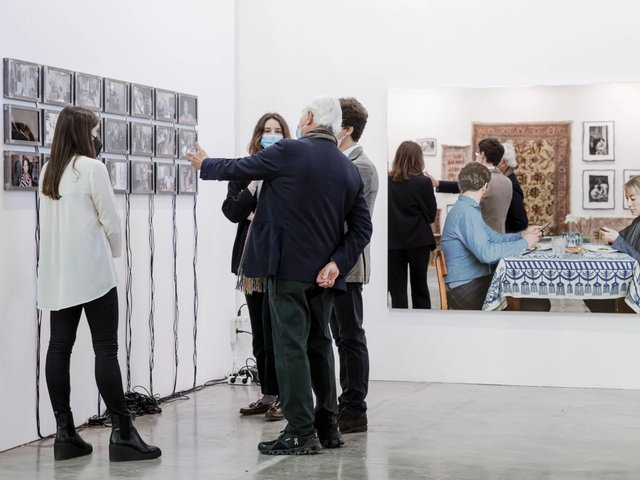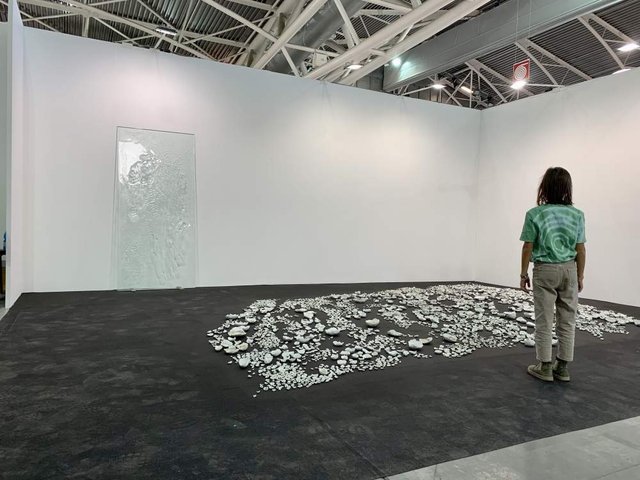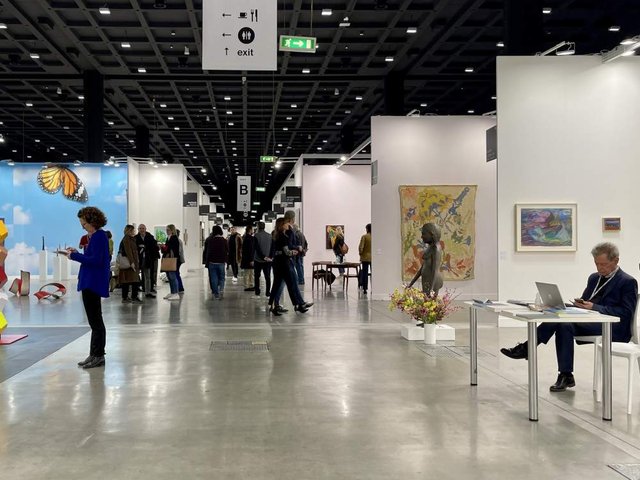Following last month's Frieze London and Paris+ par Art Basel, another key European fair is testing the market in tumultuous times. Artissima in Turin, Italy's leading contemporary art fair, yesterday opened its landmark 30th edition (until 5 November), with 181 galleries participating, 79 of which are Italian.
Geopolitical events—namely the unfolding tragedy of the Israel-Hamas war and the ongoing war in Ukraine—are a concern on the fair floor. “We can feel instability in the art field. The next six months will be difficult. All is going well for us and it will be a good year,” says a spokesperson for Thomas Brambilla gallery in Bergamo. The gallery has participated in the past ten editions of the fair, and by the end of the fair's VIP preview (2 November), it had sold works by Maggi Hambling and a sculpture by Bryan Hunt, along with a John Giorno painting to a private collector based in Italy priced at €35,000. Brazilian and German collectors were also in attendance, according to the gallery spokesperson.
The tumultuous backdrop is affecting the market in a number of ways. “The cooling of sales at auction is also positive as it means the [buying] field is cleared and it brings the positive aspect of reducing the amount of buyers who only collect [as speculators],” says Vincenzo della Corte of Vin Vin gallery, which runs spaces in Naples and Vienna. The gallery is selling works by the Nigerian-born London-based artist Jamiu Agboke priced between €5,000 and €30,000 (a large-scale work was sold to a “very important international collection” for €20,000).
Other dealers are sensing jitters. Fabrizio Padovani of Bologna's P420 gallery added: “Something is already visible in terms of collectors. Frieze London and Paris Internationale were not as fizzy as last year. It is an uncertain general economic moment especially in terms of [rising] interest rates.” The European Central Bank’s key interest rate is 4% (the rate was paused in October after ten consecutive hikes).
Paola Biasutti of Biasutti & Biasutti gallery of Turin says that she has seen mainly Italian collectors. “People feel this situation but it’s too early to judge the economic consequences; many collectors don’t seem worried about it,” she said. The gallery, which has devoted its stand to Arte Povera artists, sold Alighiero Boetti’s Manifesto (1967) to an Italian collector. A pair of works by Gianni Piacentino are priced at €22,000 and €30,000.
The London-based dealer Thomas Dane has a unique perspective on the Italian market, having opened a gallery in Naples in 2018. ‘Taking part in an Italian fair makes much more sense for us now we have a gallery in Italy and Artissima is the best of the Italian fairs,” he says. He had sold a number of works by the London-based artist Jake Grewal by the end of day one.
Sales were indeed fairly brisk with a photograph by Helena Almeida at Galeria Francisco Fino (Experiência do lugar II, 2004), among the highest priced works. It was bought for €100,000 by a private European collection. Lower price point sales were numerous: Mazzoleni gallery sold two collages by Marinella Senatore (Opera!, 2023) priced between €15,000 and €18,000. The gallery also sold Senatore’s We Rise by Lifting Others (2023), made of LED bulbs, for around €60,000. A solo presentation by the New York-based artist Jennifer J. Lee at The Sunday Painter gallery sold out (£9,500-£14,000).
Galleries from 33 countries are taking part in this year's Artissima with 39 showing for the first time, including Cristina Guerra (Lisbon) and Raster (Warsaw). So is the fair now a major player on the international scene or rather a key regional event? 60% of participating galleries are not Italian, says the director Luigi Fassi, stressing the international flavour of the event.
“It’s a trend that has continued for years. The fair is very attractive to a generation of galleries from international markets…. But it is an Italian fair and we’re proud of that—the entire Italian scene shows up from museum directors to collectors and journalists. You can say the fair serves as a bridge between the Italian scene and the international scene,” he added.
Fassi pointed out that the organisation of Artissima is overseen by Artissima srl, a company affiliated with Fondazione Torino Musei. “We do not belong to an international or commercial group. Our Artissima brand is fully owned by the Città di Torino, Regione Piemonte and Città Metropolitana di Torino. This is also why we can keep [stand] prices reasonable.”
This chimes with the general theme of Relations of Care which comes from a 2022 text by the academic Renzo Taddei. “This is a human scale art fair. It’s not about blue chips, it’s about seeking values and discoveries,” he added.
And what is Fassi’s view on current events globally? “What I see is a sense of relief [at Artissima]—spending a few days in a human environment, spending quality time together and seeing excellent shows in town. Maybe there is some hope that things might get better if we can talk to each other [sharing] our ideas.”





